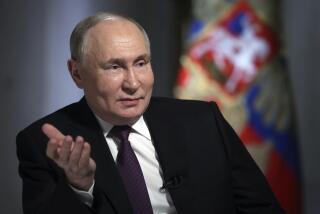U.S. Worried by Nuclear Security in Unstable Soviet Empire
WASHINGTON — If the Soviet Union fragments under its increasing ethnic, national, political and economic stresses, who will inherit its nuclear weapons?
As its East European empire disintegrates, could the nuclear warheads and artillery shells stored in East Germany be diverted or captured by local forces who might reject Moscow’s authority?
Those questions, largely discounted in the past, have grown important to U.S. officials in recent months as Soviet President Mikhail S. Gorbachev’s reforms have unleashed centrifugal forces at home and in Eastern Europe. Officials in the Central Intelligence Agency and elsewhere in the government are trying to determine how well the Soviets protect their nuclear devices.
Their conclusion is that the odds of unauthorized access to the Soviets’ 25,000 or more nuclear weapons remain extremely small, whether the threat is from a Muslim zealot in Uzbekistan, a Baltic nationalist or a mutinous faction of the Red Army.
But “however unlikely the chances of diversion,” Yale University expert Paul Bracken said last month, “the consequences would be so great that the U.S. government is right to keep a close watch on the situation” by monitoring communication channels and other intelligence indicators.
“We must face the fact that by the end of the century, the Soviet Union may not be Soviet and not a union,” said a U.S. expert who asked not to be identified. In a reference to one of the 15 constituent Soviet republics that have nuclear weapons, he asked: “Will the fourth biggest nuclear power be Kazakhstan?”
A senior U.S. official said that of all the potentially risky possibilities, the most realistic is the breakup of the Soviet Army, with various commands possessing nuclear weapons and their enabling codes.
But there is also concern about the dangers spawned by unpredictable conditions in Central Europe, where both Soviet and U.S. nuclear weapons are stored. “It was unthinkable until recently,” one military strategist said, “but that (military) theater has become so unstable that it’s a good argument to withdraw all nuclear weapons, just to preclude something totally off the wall from happening to them.”
“It has been true historically that these things don’t happen when you have strong central control of the military,” Bracken said. “But in the last six months, we’ve seen 85 things that should never have happened either. This is a new time in which God knows what may happen.”
U.S. officials have seen enough violence in Soviet Georgia, Armenia and Azerbaijan to be concerned. They took note when ethnic rioters seized a police armory in Fergana, Kazakhstan, in June, killing more than 20 people. And it was not lost on them that the Red Army newspaper has carried stories about insubordination among Baltic, Georgian and Uzbek recruits.
Lingering in the minds of U.S. planners are memories of the popular insurrection last June in China, where an army faction appeared close to mutiny and the nation may have verged on civil war.
Whether the dissident military units had nuclear weapons is unclear. Chinese officials, according to Bracken, have deflected questions on that subject by insisting that there were no problems.
“They can’t imagine how trouble could occur,” Bracken said, “and that upsets me because it means they haven’t really thought it through and they haven’t spent hundreds of billions of dollars like we have to control the weapons.”
One source said the United States has helped China devise electronic locks, called permissive action links or PALs, for its nuclear weapons. Pentagon officials knowledgeable about such issues refused to discuss the subject.
The United States developed PALs in the 1960s after members of Congress, visiting Europe, saw West German aircraft with U.S. nuclear bombs on board sitting on alert at the end of runways. The bombs contained no protective devices, and a single U.S. sentry with an M-1 rifle provided the only insurance that the pilots would not take off without authorization.
Now, all U.S. warheads and bombs for long-range missiles and aircraft of the Air Force--but not the Navy--have several devices to prevent any accidental firing, diversion or other use unauthorized by the President.
Fuses on bombs will not work if they have not experienced free fall from an aircraft. Enabling electronic codes must be received to unlock the PALs. Finally, most U.S. nuclear weapons contain devices that will render the weapons incapable of producing a nuclear blast if attempts are made to bypass the safety mechanisms or break the enabling codes.
More than two decades ago, the United States tried to interest the Soviets in safety devices for their weapons. Moscow ignored the overture but has since paid increasing attention to the matter. In 1982, for example, Soviet Defense Minister Dmitri F. Ustinov publicly called for greater effort to prevent “the unsanctioned launch of Soviet nuclear weapons.”
Whether the U.S. and Soviet militaries have exchanged assurances on nuclear weapon safety is not known. Last summer, for example, a group of U.S. officials, including military officers, attended a conference on nuclear safety in Moscow. But the Americans were disappointed at Soviet reticence, according to one official.
Because the Soviets were considerably behind the United States in adopting safety devices, they may not have any electronic locks comparable to U.S. PALs on their short-range systems, even though Soviet long-range missiles are protected at least as well as U.S. weapons, Stephen Meyer of the Massachusetts Institute of Technology wrote in “Managing Nuclear Operations.”
More to Read
Sign up for Essential California
The most important California stories and recommendations in your inbox every morning.
You may occasionally receive promotional content from the Los Angeles Times.









